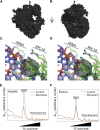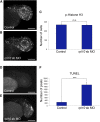A novel ribosomopathy caused by dysfunction of RPL10 disrupts neurodevelopment and causes X-linked microcephaly in humans
- PMID: 25316788
- PMCID: PMC4196623
- DOI: 10.1534/genetics.114.168211
A novel ribosomopathy caused by dysfunction of RPL10 disrupts neurodevelopment and causes X-linked microcephaly in humans
Abstract
Neurodevelopmental defects in humans represent a clinically heterogeneous group of disorders. Here, we report the genetic and functional dissection of a multigenerational pedigree with an X-linked syndromic disorder hallmarked by microcephaly, growth retardation, and seizures. Using an X-linked intellectual disability (XLID) next-generation sequencing diagnostic panel, we identified a novel missense mutation in the gene encoding 60S ribosomal protein L10 (RPL10), a locus associated previously with autism spectrum disorders (ASD); the p.K78E change segregated with disease under an X-linked recessive paradigm while, consistent with causality, carrier females exhibited skewed X inactivation. To examine the functional consequences of the p.K78E change, we modeled RPL10 dysfunction in zebrafish. We show that endogenous rpl10 expression is augmented in anterior structures, and that suppression decreases head size in developing morphant embryos, concomitant with reduced bulk translation and increased apoptosis in the brain. Subsequently, using in vivo complementation, we demonstrate that p.K78E is a loss-of-function variant. Together, our findings suggest that a mutation within the conserved N-terminal end of RPL10, a protein in close proximity to the peptidyl transferase active site of the 60S ribosomal subunit, causes severe defects in brain formation and function.
Keywords: X-linked; microcephaly; ribosome; translational elongation; zebrafish.
Copyright © 2014 by the Genetics Society of America.
Figures




Comment in
-
Understanding rare disease pathogenesis: a grand challenge for model organisms.Genetics. 2014 Oct;198(2):443-5. doi: 10.1534/genetics.114.170217. Genetics. 2014. PMID: 25316782 Free PMC article.
References
-
- Ben-Shem A., Garreau de Loubresse N., Melnikov S., Jenner L., Yusupova G., et al. , 2011. The structure of the eukaryotic ribosome at 3.0 A resolution. Science 334: 1524–1529 - PubMed
-
- Bicknell L. S., Walker S., Klingseisen A., Stiff T., Leitch A., et al. , 2011. Mutations in ORC1, encoding the largest subunit of the origin recognition complex, cause microcephalic primordial dwarfism resembling Meier-Gorlin syndrome. Nat. Genet. 43: 350–355 - PubMed
Publication types
MeSH terms
Substances
Grants and funding
LinkOut - more resources
Full Text Sources
Other Literature Sources
Molecular Biology Databases

